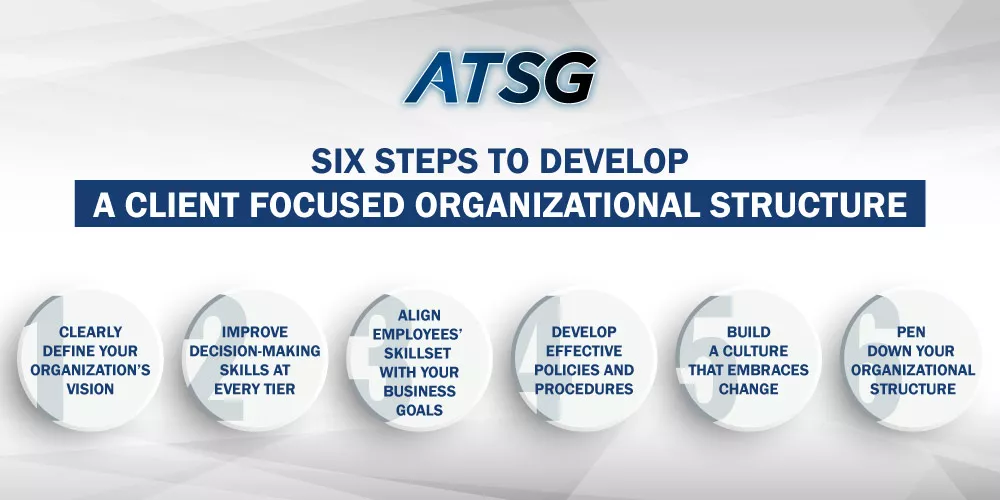We often hear business leaders announcing these adages that “customer satisfaction is our top priority”, or “we put customers’ needs above all”. However, many times, these organizations have no idea how to convert this customer-focused “mantra” into an actual practicing reality.

In the real world, there is no “magic trick” or “secret sauce” for creating an effective organizational structure that seamlessly revolves around customers’ needs. It requires the development of a strategic hierarchy that is in accordance with your enterprise’s goals. It also requires a lot of emphasis on satisfying and prioritizing customers, as they are the lifeblood of a company.
The question that arises here is, what exactly is it that makes any business a client-oriented organization? Remember that it’s an achievable, albeit difficult task. In this post, we discuss the six important steps that can help your business foster a client-focused organizational structure for improved customer experiences (CX).
1. Clearly Define Your Organization’s Vision
It is imperative that businesses clearly communicate their vision with the entire workforce. They need to “set their priorities straight” about the kind of leadership they want to pursue. Effective strategic objectives must be defined, so that every employee will have a clear set of directions, and can work with increased efficiency.
This will allow businesses to design and organize their enterprise-wide structure around their customers. This will also enable businesses to seamlessly tailor their programs or processes according to their customer’s needs.
2. Improve Decision-Making Skills at Every Tier
Organizations should make sure they have created an enterprise-wide structure that boosts speedy decision-making processes. Employees are better able to come up with quick responses to customer demands, provided everyone’s roles and responsibilities are clearly defined.
Businesses should also broaden their data scope, and use innovative technologies such as Artificial Intelligence (AI), to make decision-making processes efficient, accurate, and centered around the benefits to customers.
3. Align Employees’ Skillsets with Your Business Goals
In order to develop a customer-focused organizational structure, businesses should invest in upskilling their workforces’ abilities, in accordance with their strategic and mid-term goals. They should also consider the following points:-
- Businesses should have a clear understanding of the current skills of their employees. They should look for ways to align them with their enterprise’s overall goals.
- They should train their employees to meet their customer’s requirements.
- Enterprises must also set up incentives to motivate employees towards efficiently performing their tasks.
- If customers expect employees to have certain certifications, businesses should figure out a way to make that happen by creating career development programs. This will satisfy both employees and customers while adding value to the organization over the long run.
4. Develop Effective Policies and Procedures
Businesses must evaluate their systems and operations on a frequent basis to check if everything is working smoothly. They should create robust processes and policies that align with their client-focused goals.
The input coming in from sales and marketing teams is extremely valuable for businesses, as it helps them engineer a customer-based product design. Additionally, businesses should empower their customer service representatives to solve any issues that clients might be facing, without having to transfer their calls over and over again.
5. Build a Culture that Embraces Change
In today’s dynamic environment, change is the only constant element. This is why businesses must work towards creating an organizational culture that is open to embracing change. This is important because otherwise, businesses will be left behind due to fierce market competition.
Enterprises should circulate questionnaires and conduct surveys to get insights as well as valuable feedback from customers regarding their products or services. It is important that businesses create understandable and mutually beneficial policies and procedures, that can evolve with time. This will result in a quick response to customers’ feedback. This will also create long-lasting customer loyalty toward your brand.
6. Pen Down Your Organizational Structure
Finally, make sure that your customer-oriented organizational structure is not just limited to your imagination, and is actually well documented. Businesses must clearly write down their “organization’s constitution” which has clear guidelines and expectations for everyone.
Look for ways to make it visually captivating by inserting charts and clearly defining each hierarchical level. Define everyone’s role and responsibilities, so your business works as a “smooth-running engine” to generate value for your customers.
Conclusion
Creating a well-planned and efficacious customer-centric business structure does not happen overnight. It requires a lot of hard work and strategic planning from the top down, along with robust execution strategies. However, if businesses manage to provide this elusive one-of-a-kind client experience, they will be able to attain and retain better customer loyalty and business growth for the foreseeable future.
If you want to embark on your digital transformation journey, feel free to get in touch with ATSG for top-notch managed IT services and intelligent technology solutions for your enterprise. Our robust solutions, such as Contact Center capabilities and Cloud offerings can help you create the perfect “enabling environment” for a client-focused structure across your enterprise.




